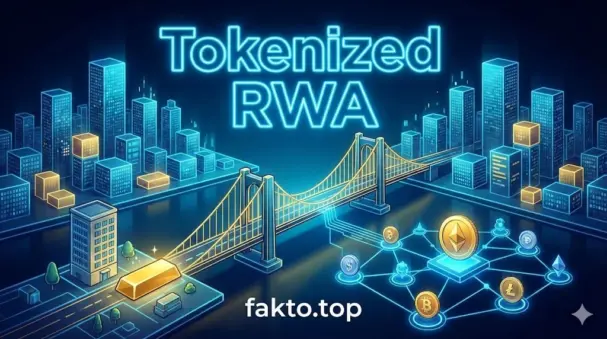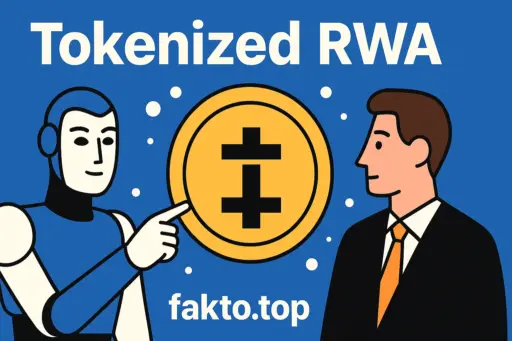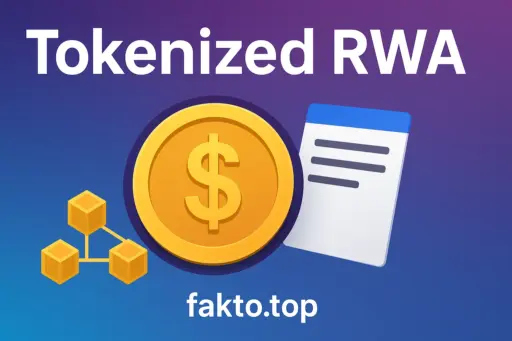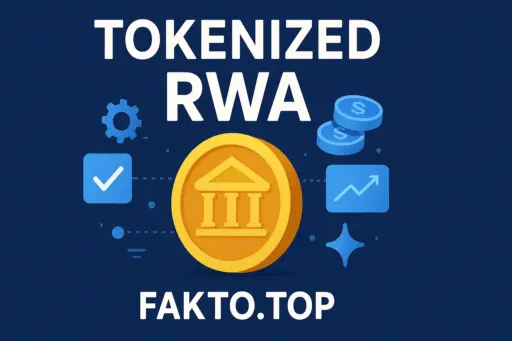Tokenized Real-World Assets (RWA): The Future of Ownership and Liquidity
Tokenized real-world assets are gaining momentum because they offer something traditional finance keeps failing to deliver: fast ownership transfer, transparent auditability, and a more flexible relationship between the asset and the investor. Instead of going through endless paperwork or dealing with liquidity traps, a tokenized asset behaves like a digital instrument backed by something solid and verifiable.

It’s not magic, even though many act like it’s some kind of universe-shaking breakthrough. In reality, it’s much more down-to-earth: a legally structured asset gets wrapped into a blockchain-based token, letting people own fractions, trade 24/7, and potentially open access to a wider pool of investors Sometimes it feels almost too convenient, but that’s exactly why this sector keeps growing, even despite the obvious legal and operational risks
How Tokenization Turns Physical Assets Into Digital Ones
The core mechanism behind tokenization looks simple on paper: an asset is evaluated, legally structured, and then mirrored on-chain through a set of tokens connected to specific rights or revenue flows.
But when you dig deeper, you notice dozens of tiny steps that determine whether the whole thing is trustworthy or just another digital wrapper.
Custodial storage, regulatory classification, disclosure standards, and smart-contract architecture all influence how safe and transparent the process is. Investors often underestimate this backstage complexity until they see two similar projects behaving completely differently.
Some RWA tokens act like clean, auditable instruments, while others feel more like promises in a pretty technical package. That contrast explains why the market is simultaneously developing and feeling nervous
Why Liquidity Matters More Than Marketing Claims
Liquidity is becoming the strongest argument in favor of RWA because investors want the ability to enter and exit positions without weeks of settlement delays. Tokenized assets enable near-instant transfers, and even though not all of them trade actively, the potential for secondary markets is significantly higher than in conventional off-chain structures.
Of course, liquidity isn’t guaranteed—a quiet market can freeze even the most technologically advanced token . But when an asset has real demand and credible structuring, tokenization acts like a booster, giving it a wider circulation path. That’s why treasury-backed tokens, private credit deals, and real estate shares are slowly moving on-chain.
They promise not just fractional access, but the freedom to move capital around without hitting bureaucratic walls every time someone wants to rebalance their portfolio.

Practical Examples Showing How RWA Works in Daily Use
Imagine a residential property split into digital shares, allowing multiple investors to co-own it without dealing with joint paperwork or slow title registries. Or take a short-term credit facility tokenized into small units so newcomers can enter a market traditionally dominated by large institutions.
There are also cases where tokenized commodities give traders exposure to physical inventory without forcing them to handle logistics or storage. These examples aren’t futuristic—they’re already running quietly across different platforms, though the quality varies a lot from project to project.
Some models feel impressively smooth, almost like handling stablecoins backed by real income streams. Others expose weak legal structuring, reminding everyone that digital form doesn’t magically fix old-school problems hiding underneath.
The Operational Backbone Behind Reliable RWA Structures
A tokenized asset is only as strong as the operational framework behind it, and this part rarely gets discussed, even though it’s exactly where most mistakes happen.
Custodians need to verify ownership, maintain records, and guarantee asset integrity without introducing layers of friction that would kill the whole point of tokenization. Legal teams must draft agreements that actually bind the real asset to the on-chain representation, not just promise it in vague wording. Technology teams handle smart-contract logic, security audits, and ongoing monitoring, because even a small flaw in contract design can turn a promising RWA into a stalled or frozen product.
When all sides work together, the system runs smoothly, confidently, and predictably, though in reality coordination is messier—kind of like early fintech projects trying to look polished while backstage everything is held together by enthusiasm and good coffee.”
Where RWA Brings the Most Value for Investors
Tokenization shines brightest in markets where access is traditionally limited or where settlement speed is painfully slow. Real estate is an obvious example: fractional ownership lets investors participate without needing full capital, and token transfers bypass sluggish registries.
Private credit is another segment gaining momentum, partly because tokenization increases transparency in deals that normally feel like a black box. Commodity-backed tokens also solve an age-old problem by giving exposure to physical inventory without logistical headaches. The overall appeal grows from a mix of flexibility and lower entry thresholds, and even though investors remain cautious, many quietly admit that RWA provides a refreshing alternative to clunky legacy systems.
It’s not about revolution, it’s about reducing friction in markets that have long ignored how uncomfortable they are to interact with.

Case Studies Showing RWA Value in Real Decision-Making
Consider a mid-size investor who wants partial exposure to commercial property but isn’t ready to manage tenants or sign bulky agreements. A tokenized structure gives exactly that: a slice of revenue, minimal involvement, and the ability to exit by selling tokens instead of negotiating contracts. Another case involves a small fund purchasing tokenized private credit instruments.
Normally such deals require days of paperwork and background checks, but here the investor receives validated, audited notes with on-chain payment flows. Even small businesses can leverage RWA when tokenized invoices provide immediate liquidity instead of waiting months for settlement.
These real-world situations show that tokenization is not just a fancy wrapper — it’s a tactical tool that solves specific inefficiencies.
Challenges and Limitations That RWA Still Struggle With
Even though tokenized assets look promising, the sector is far from perfect. Regulatory clarity remains patchy, and sometimes agencies themselves seem unsure how to classify different token models. Custodial risk is another sore spot: if a custodian mismanages the asset, the token loses meaning instantly, no matter how elegant the smart contract is.
Liquidity also fluctuates more than enthusiasts like to admit, and a quiet market can leave investors stuck, holding a digital share they expected to trade quickly. There’s also a psychological barrier — not everyone feels comfortable trusting digital contracts for assets worth hundreds of thousands.
This hesitation isn’t irrational; the market is still young, and .the market is still young, and unfortunately, not all projects follow strict operational discipline..
But awareness of these issues helps investors make more grounded decisions instead of blindly following the hype.
Why RWA Still Move Forward Despite the Limitations
The most interesting part is that even with clear weaknesses, the momentum around RWA keeps building. The reason is straightforward: traditional markets are too slow, too fragmented, and too bureaucratic to satisfy modern capital flows.
Tokenization may not solve everything instantly, but it solves enough to make the shift feel inevitable. Investors like having instruments that update in real time, settle instantly, and remain traceable without drowning in admin work. Institutions appreciate transparency and lower operational costs.
Retail investors enjoy fractional access and the sense of fairness often lacking in old-school finance. So yes, there are flaws, and sometimes the optimism feels a bit excessive, but the momentum is unstoppable. The system simply offers too many advantages to be ignored.

Tokenization Models and How They Shape Investor Expectations
Different RWA models create very different risk profiles, and this is where many newcomers get confused. Some tokens represent direct ownership, giving holders a legal claim to the underlying asset. Others work as revenue-sharing instruments tied to cash flow rather than the asset itself.
There are also synthetic structures that simply mirror price exposure without granting any ownership at all. These variations shape how investors behave and what they expect from returns, liquidity, and governance. A direct-ownership token might sound safer, but it can come with heavier regulatory obligations.
A cash-flow token feels more flexible, though income stability depends on how well the underlying business performs. Synthetic models are cleaner on the technical side, yet they rely heavily on trust in platform operations.
There’s no perfect structure, just different setups that investors should evaluate with a cold head and a bit of skepticism.
Real Examples of Tokenization Models in Action
Take a token that represents fractional ownership of an income-producing warehouse. Investors receive a portion of rental payments, and the asset itself stands as collateral. This model feels predictable, though rental markets occasionally behave strangely, especially during economic shifts.
Another example is a tokenized private loan where investors buy a share of interest payments rather than ownership of the borrower’s collateral. It’s simpler, faster, and usually more liquid, but credit risk jumps front and center. Then there’s the synthetic commodity token mirroring the price of metal inventories without giving storage rights.
Traders love it because it’s clean and flexible, though skeptics argue it disconnects too much from physical reality.
These cases highlight how tokenization isn’t a single formula — it’s a spectrum of structures tailored to different purposes.
Market Dynamics That Influence RWA Adoption
Demand for RWA doesn’t grow in a vacuum. Macroeconomic pressure, interest-rate shifts, and tightening liquidity in traditional markets all play a role. When rates rise, capital becomes more cautious, and investors look for transparent structures that provide stable yield.
When the economy slows, tokenized assets offering fractional access become suddenly attractive because they lower the barrier to entry. Even institutional players, who once ignored the entire tokenization trend, now explore it as a way to streamline settlement processes and broaden investor pools. At the same time, market cycles introduce natural volatility.
A booming period pushes adoption faster, sometimes too fast, while quieter phases expose structural weaknesses. It’s an evolving ecosystem, and nobody can honestly claim to predict where the line will settle.
Still, the directional trend looks resilient (or stable): more assets are being wrapped, more platforms emerging, and more investors quietly shifting part of their strategy toward digital rails.
Case Scenarios Showing Market Dynamics in Real Life
A rising-rate environment often pushes investors toward tokenized treasury products because they deliver stable returns with efficient settlement. That’s exactly why such offerings gained traction recently — the combination of yield and blockchain rails feels unusually practical. In another scenario, during a liquidity squeeze, small investors use tokenized real estate shares to reposition capital quickly instead of waiting weeks for traditional intermediaries.
Then there’s the case of commodity traders turning to tokenized warehouse receipts when logistics slow down; tokens let them maintain exposure without getting stuck in operational bottlenecks.
Each scenario reveals a pattern: when traditional markets experience familiar headaches, tokenization steps in as a pressure-release valve, offering smoother access and faster execution.
Risk Management Principles Every RWA Investor Should Consider
RWA may feel innovative, but the risks resemble classic finance more than many want to admit. Legal clarity matters because if the asset isn’t properly tied to the token, ownership becomes ambiguous. Custodial risk matters because a token without a secure asset is just a decorative entry in someone’s database.
Smart-contract reliability matters because minor flaws can freeze an entire issuance. And liquidity risk remains ever-present — even well-designed assets can sit idle during quiet market periods. Investors should evaluate governance, disclosures, asset audits, and redemption mechanisms with a healthy mix of optimism and doubt.
The goal isn’t to eliminate risk; that’s impossible. The goal is to understand it clearly enough to decide whether the potential reward justifies the exposure.
And honestly, sometimes the answer is yes — but sometimes walking away is the smartest strategy.
How Investors Can Approach RWA Strategically
A practical approach to RWA starts with clarity on what you actually want: income, price appreciation, diversification, or access to otherwise locked markets. You don’t need to own entire properties, bonds, or commodity inventories; fractional exposure often suffices.
Start small, analyze token structures, check custodial arrangements, and evaluate distribution mechanisms. It’s tempting to chase high yields or flashy projects, but careful diligence beats impulse every time.
Pay attention to governance: who decides when to liquidate, how disputes are resolved, and whether the smart contracts truly match legal agreements.
Another key factor is liquidity planning — even with tokenized assets, some markets move slower than advertised, and you may find yourself holding for longer than expected.
A measured strategy balances opportunity with control and maintains flexibility without exposing you to unnecessary blind spots.
Case Examples of Strategic Investment
One mid-sized fund allocated a small portion to tokenized commercial real estate shares. They structured entry and exit windows according to expected rental cash flows, creating predictable distribution cycles.
Another investor experimented with tokenized treasury bills to diversify across geographies without triggering local tax complications. In both cases, the projects worked, but not perfectly: one property had a minor legal hiccup slowing payout, and a treasury platform required manual reconciliation for some transfers.
These examples show that strategy is less about perfect execution and more about anticipating friction points and planning around them. Even with the occasional glitch, disciplined planning enabled participation in markets that would otherwise be unreachable.
Integrating RWA into a Broader Portfolio
Tokenized real-world assets shouldn’t exist in a vacuum. The best results appear when RWA complements traditional holdings, crypto-native instruments, and alternative assets. For example, a balanced portfolio might include tokenized real estate for steady income, tokenized bonds for stability, and selective DeFi positions for high growth potential.
Correlation and risk exposure should be analyzed at the portfolio level, not per token. Fractional ownership helps scale this integration because you can adjust exposure without liquidating other positions. Still, skepticism is healthy: just because something is tokenized doesn’t mean it automatically improves your risk-return profile.
Proper monitoring, rebalancing, and understanding operational limitations are essential for avoiding unpleasant surprises.
Portfolio Case Scenario
A small institutional investor incorporated tokenized private credit and tokenized real estate alongside traditional equity and bonds. They created exposure thresholds to avoid overconcentration in any single token type. Early returns were moderate but consistent, and when one property faced a temporary liquidity hiccup, other holdings provided buffer
The outcome illustrated how RWA, even with imperfections, could smooth portfolio volatility and enhance accessibility. The key lesson: treat tokenized assets like any other instrument, but with the added responsibility of understanding how blockchain, custody, and legal frameworks interact.
Analytical Table: Comparing Key RWA Categories
| Asset Type | Liquidity Potential | Risk Level | Investor Suitability |
|---|---|---|---|
| Tokenized Real Estate | Medium | Medium | Income-focused, long-term holders |
| Tokenized Commodities | High | Low to Medium | Active traders, hedgers |
| Tokenized Bonds / Treasuries | High | Low | Conservative, yield-focused investors |
| Tokenized Private Credit | Medium | High | Experienced, risk-tolerant investors |
Regulatory and Compliance Considerations for RWA
Regulation remains one of the most unpredictable factors in the RWA space. Each jurisdiction treats tokenized assets differently, creating a patchwork of rules that can confuse even seasoned investors.
Some assets require strict licensing, full KYC verification, and disclosure reports, while others operate in gray areas, relying on legal interpretations that may or may not hold up. Investors must approach this with a mix of curiosity and caution: ignoring compliance can lead to frozen assets or legal disputes, but overestimating regulation can result in missed opportunities.
The trick is to understand both local laws and platform policies, verify that custodians and issuers adhere to standards, and always question whether a token truly represents ownership or just cash flow rights. In short, regulatory clarity lags behind innovation, and patience plus due diligence are essential.
Case Example: Navigating Regulatory Complexity
A European investor bought tokenized shares in a commercial property fund. The platform had strong compliance frameworks, but the investor still needed to navigate tax reporting rules and confirm that cross-border transfer restrictions wouldn’t block eventual sales.
The process was slower than expected, but the final outcome validated the effort: the investor could safely hold, transfer, and eventually liquidate the tokens without legal risk. This illustrates that compliance is not just paperwork—it directly affects liquidity, access, and confidence.
Even in mature markets, overlooking these considerations can quickly turn a promising RWA investment into a frustrating experience.
Technological Infrastructure Driving RWA Efficiency
Blockchain and smart contracts form the backbone of RWA, but the technology alone is insufficient without proper operational and legal integration. Platforms must manage token minting, distribution, payment flows, and automated reporting while ensuring audits and security checks are in place.
Oracles often bridge on-chain and off-chain data, verifying valuations, income, or collateral. Without this, tokens may look solid but fail when investors attempt transfers or claim entitlements. Advanced platforms integrate monitoring dashboards, automated dividend distributions, and even partial liquidation mechanisms to ensure smooth operation.
Yet technology is never foolproof—bugs, misconfigurations, or overlooked edge cases can disrupt payouts or liquidity. The best projects anticipate these risks, balancing technical elegance with operational pragmatism.
Case Scenario: Technology in Action
A tokenized warehouse receipt project used smart contracts to automatically distribute rental income to token holders every month. Initially, minor oracle mismatches caused delayed payouts, but the platform quickly patched the issue. Investors gained confidence seeing transparency and automation work in real time.
This example underscores that technology enhances efficiency and trust, but human oversight and iterative improvements remain critical. Even automated systems require checks, because real-world assets are messy, valuations fluctuate, and legal nuances often override code logic.
The lesson is clear: smart contracts improve reliability, but they don’t remove all friction, and investors need to account for operational variability when planning strategy.
Analytical Table: RWA Risk vs. Liquidity Across Asset Types
| Asset Type | Liquidity Potential | Regulatory Complexity | Operational Considerations |
|---|---|---|---|
| Real Estate | Medium | High | Title verification, property management |
| Government Bonds | High | Medium | Compliance reporting, custodial checks |
| Commodities | High | Medium | Physical storage, audit verification |
| Private Credit | Medium | High | Contract enforcement, credit monitoring |
Future Outlook for Tokenized Real-World Assets
The trajectory of RWA looks promising, though not without bumps. More institutional players are exploring tokenized instruments, and platforms continue expanding offerings across real estate, commodities, bonds, and private credit. The appeal is clear: faster settlement, fractional ownership, and digital transparency. However, adoption depends on solving persistent challenges like legal clarity, custody risk, and liquidity depth.
Technological improvements, coupled with clearer regulatory frameworks, are expected to make RWA more mainstream over the next few years. Investors who understand both the potential and the limitations can gain an edge by entering early while remaining cautious.
The market is evolving rapidly, but the underlying idea—bridging physical assets and digital liquidity—is likely to remain central in finance for decades to come.
Case Scenario: Early Movers in RWA
A mid-sized investment firm integrated tokenized commercial real estate and treasury-backed instruments into its portfolio two years ago. Initial challenges included regulatory review delays and liquidity constraints on secondary markets.
Over time, as platforms refined operations and investor confidence grew, the firm saw measurable portfolio benefits: smoother cash flows, fractional flexibility, and exposure to previously inaccessible assets.
The lesson: early adoption carries operational hurdles, but the first movers often capture structural advantages that later entrants cannot easily replicate. It highlights the importance of hands-on diligence, willingness to navigate minor frictions, and long-term perspective when approaching tokenized real-world assets.
Strategic Recommendations for Engaging with RWA
Approaching RWA requires a combination of skepticism, discipline, and strategic focus. Begin with assets whose value proposition you understand and where legal and operational clarity is established. Diversify across token types and markets to mitigate unexpected liquidity issues.
Maintain active oversight of smart-contract updates, custodial reports, and regulatory developments. Plan exit strategies in advance; even digital markets have friction and delays.
Lastly, balance optimism with realism—RWA opens doors, but it doesn’t erase traditional market risks. Thoughtful engagement, rather than blind enthusiasm, tends to yield the most reliable returns and minimizes unpleasant surprises.
Case Scenario: Balanced Engagement
An individual investor allocated a modest portion of capital to tokenized private credit, treasury-backed tokens, and fractional real estate. By monitoring market liquidity, operational updates, and legal compliance, they achieved moderate yet consistent returns, while avoiding overexposure to any single risk factor.
Temporary hiccups in one property’s revenue did not destabilize the overall portfolio because other tokenized assets maintained steady cash flows. This approach demonstrates that RWA, when carefully integrated, can complement traditional holdings and offer access to markets that were previously inaccessible or inefficient.
Proper due diligence and ongoing monitoring remain key to maximizing benefits while controlling downside risks.
Disclaimer
The information in this article is provided for educational and informational purposes only.
Tokenized real-world assets involve complex legal, financial, and technological risks, and the examples or case studies mentioned do not constitute investment advice. Investors should conduct their own due diligence, consider their individual risk tolerance, and consult with legal or financial professionals before engaging with any RWA platform or instrument.
Past performance or operational examples do not guarantee future results.
Digital tokens representing real-world assets are subject to regulatory changes, liquidity fluctuations, and operational risks that can impact outcomes.
Use this content as a guide to better understand the landscape, but not as a definitive recommendation to buy, sell, or hold any asset.
